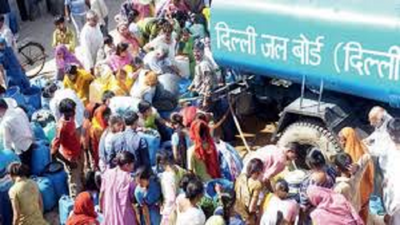- News
- City News
- delhi News
- Delhi has extracted almost all of groundwater available
Trending
Delhi has extracted almost all of groundwater available
Delhi faces a water crisis as CGWB reports a decrease in annual groundwater recharge to 0.38 bcm in 2023. 99.1% of available groundwater has been extracted, posing sustainability challenges.

File photo
According to the report, Delhi's net annual groundwater recharge in 2023 was estimated at 0.38 billion cubic metre (bcm), of which 0.34 bcm was available for extraction.Alarmingly, nearly all of the available groundwater has been extracted. This means 99.1% of the groundwater has been extracted. In comparison, the annual groundwater recharge in 2022 was 0.41 bcm, with 0.37 bcm available for extraction and 0.36 bcm actually drawn out.

The report highlighted the increase in Delhi's groundwater extraction from 98.16% in 2022 to 99.13% in 2023, despite the decrease in groundwater recharge during the same period. This indicates that while some areas have made progress in maintaining safe groundwater levels, Delhi still faces significant challenges in managing its groundwater resources sustainably.
The CGWB report happily noted an increase in the urban areas classified as "safe" in terms of groundwater levels, with 15% of Delhi's assessment units falling under this category in 2023 compared with 12% in 2022. In sharp contrast, however, the areas facing a critical groundwater situation also expanded from 21% of the city in 2022 to 35% in 2023.
CGWB assesses groundwater across 34 tehsils in Delhi, each referred to as an assessment unit.
Of these 34 assessment units, 13 (38%) were categorised as 'over-exploited', 12 (35%) as 'critical', four (12%) as 'semi-critical' and five units (15%) as 'safe'.
Since 2022, there have been improvements, such as an increase in the number of tehsils in the safe zone from four to five, a decrease in the number of semi-critical tehsils from eight to four, and a reduction in over-exploited areas from 15 to 13. However, the number of critical areas has increased from seven tehsils in 2022 to 12 in 2023.
To address the groundwater alarm, CGWB has recommended making rainwater harvesting in water-depleted areas mandatory, increasing the use of treated water and creating awareness through mass awareness campaigns for public and farmers, training programmes for personnel engaged in the water sector, and educational activities such as painting and elocution contests themed on water conservation for school students.
The report added, “More sewage treatment plants and use of this water for other than domestic use may be planned and implemented religiously.”
End of Article
FOLLOW US ON SOCIAL MEDIA










